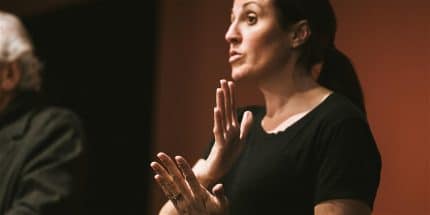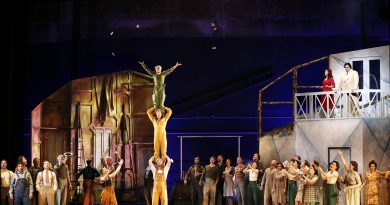Accessibility in the theatre industry – is digital technology the way forward?
We’re well past the halfway point of 2020, and most major theatres have been closed for over 6 months.
However, despite the COVID crisis prohibiting the arts industry to thrive as it normally would, we have seen major developments, particularly in the technological space. Companies are adapting to the ever-changing digital landscape and producing full scale shows online, such as Who’s Your Baghdaddy and The Big One-Oh!. Variety shows are being organised and performed, with many having tuned in weekly to The Iso-Late Late Show, Lights Up on the Arts, and The Reservoir Room. Hope: New Work Development Initiative and HomeGrown gave platforms for new and emerging artists to workshop and develop their work.

Our industry managed to, in a sheer matter of weeks, pull together and create something new and wonderful to fill the theatre-sized void that Coronavirus was creating. But with all this new development, a larger question arose in my mind. I am able to watch this content from the comfort of my home, but I have the option once theatres reopen, to go out and see live theatre in the more traditional theatre space. What about those who cannot? The use of digital technologies for creating theatre accessibility could be a major positive to come out of this time of crisis.
Theatre inaccessibility has been an issue far longer than the pandemic has been around. There are a multitude of reasons for this – on a basic level, not all Australians live in close proximity to theatres. Those living more rurally, or simply in a state which is not often included in major touring destinations, will miss out on major productions unless they travel in – a costly process that not all can afford.
45 percent of Australians between the ages of 16 and 85 experience some form of mental health condition in their lifetime [1]. For some, leaving the house is a laboured task, and providing a way for them to enjoy their theatre experience from home can greatly benefit their overall wellbeing – there are countless studies discussing how drama and the arts can psychologically and emotionally improve mental health, with initiatives like the Arts Wellbeing Collective being founded on such a premise.
In 2018, the Australian Bureau of Statistics reported that there are 4.4 million Australians living with a disability, making up 17.7% of our national population [2]. Of this group, 11.6% are people aged between 0 and 64 years – in this article I will be using the term ‘disabled’ as a larger umbrella term for a range of audience members living with physical, intellectual, sensory, neurological, and psychiatric disabilities, amongst others.
While most of our large theatres in Australia have wheelchair accessible spaces, tickets available for patrons using wheelchairs make up a severe minority in comparison to the 1000+ seats in a major house. For those requiring an accessible space, these are often snapped up early into a show’s booking period, limiting the dates and times one can visit the theatre. Smaller fringe or independent spaces sometimes don’t even have the ability to provide this, meaning audience members who need accessible seating are completely excluded from the viewing experience.
More recently, companies have been better with audio-described productions or assisted listening devices, but this is not a widespread approach. Similarly, relaxed and interpreted performances have increased, but not on a widespread level. With 1 in 6 Australians affected by hearing loss [3], it seems odd that productions only have a handful of Auslan interpreted shows, if any at all.
Tom Middleditch, Artistic Director of A_tistic Theatre, said:
Originally, relaxed performances were designed primarily for children, high needs children, and their families to be able to attend cultural events and artistic performances in comfort and without the fear of criticism for the different ways their children would behave in the settings. The more relaxed performances we’re able to create, the more performances that are informed by a relaxed aesthetic, then there are more options there are for all stripes of people to be able to attend art events, attend the cultural conversation that we continue to have on our stages.
With approximately 1 in 70 Australians on the Autism spectrum [4], I question why relaxed performances are not more common (especially since they benefit so many more than just Autistic people). While we do have fantastic companies like A_tistic in Victoria, who create theatre by and for autistic lives and consult with existing companies to assist with neurodiversity, our industry should be pushing for more widespread engagement with their services, and encouraging funding and resources to support their work and advocacy.
So, how can digital theatre help with accessibility?

Amidst the pandemic shutdowns, we have seen several large-scale companies releasing content online for viewing. Notably, Britain’s National Theatre have released professionally shot (pro-shot) footage of plays from their archive. These were all uploaded with closed captioning, and a couple shows even had a second, audio-described version uploaded as well. It can be done. Andrew Lloyd Webber’s ‘The Shows Must Go On’ channel saw both his own and other musical productions uploaded, all with closed captioning included. These captions may not seem like much to the layman theatre-goer, but their benefit stretches beyond just those deaf and hard of hearing. Captioning is an extremely useful tool for those whose first language isn’t English, it helps when performers have a strong accent or do not speak particularly clearly, and finally, they can be a great tool for Autistic people or those with attention deficits to maintain focus and concentration. All of these viewers have their experience compromised when in a conventional performance.
The Opera industry has historically used surtitles (text above the stage) in performances so that audiences can follow along with complex dialogue and action, particularly if the production is being performed in a language different to the country in which it is being shown. Is this not a system we could implement with mainstage plays and musicals? Would it severely impact the quality of production to have captioning visible somewhere on the stage? Why is it that only foreign language productions seem to have captions in Australia, when over 20 percent of Australians speak a language other than English at home [5]?
The inclusion of Auslan interpretation alongside streamed footage or recordings can also greatly assist those deaf and hard of hearing audience members. Auslan Stage Left are the only Auslan interpreter booking service that focuses solely on the Arts, and continually collaborate with companies and producers for a variety of events.
Communications co-ordinator Melissa Smith shared what Auslan Stage Left have been working on through the pandemic:
Over recent months, our interpreters have worked in meetings, workshops, storytelling, festivals, panels, music events. We have worked on interpreting and translations of pieces of work, where the interpreter is provided with the material to be translated into Auslan and then they film at their own location and send the video file back to the company for distribution. It would be great if companies could add accessibility to the initial planning of their events, rather than waiting for us to approach them on behalf of a Deaf person who has requested the access.
We strongly believe that Deaf and HoH people have a right, like all Australians, to access and participate in arts and cultural activities. As Sign language is the preferred method of communication for many deaf people, we enable Auslan access to arts and entertainment. Deaf people feel more comfortable and have a higher level of comprehension in Auslan via the use of an interpreter.

Streaming allows for sensory adjustments (such as having lights on, turning down volume, pausing or stopping for breaks) for those who may have triggers or sensory overloads when typically viewing theatre. Further, for both those with disabilities requiring assistive walking devices and those who may not financially be able to regularly access theatre, home streaming brings the content to the viewer’s home.
These measures take time and effort, but maybe now, while we are on an ‘intermission’ through the pandemic, is the perfect time for them to be worked into our theatre culture ahead of its return. These adjustments are rarely, if ever, made in staged productions. Why should part of our demographic suffer? Of course, with all this being said, it brings in the larger discussion of filming productions for digital distribution as a whole – something that I may touch on at a later date. And this isn’t to say that this content should be uploaded for free, as many companies have been doing during the pandemic. I know many people who are ready and willing to pay ticket admissions for streaming a production. But simply having the option to watch from home can make the world of difference to many.
With a second wave already affecting parts of the country, I implore companies to start re-evaluating the way in which they can be more accessible – not just when our theatres reopen, but in the interim.
It’s 2020 and we’re in the age of technology. Let’s use it.
This article was written in consultation with Auslan Stage Left and A_tistic Theatre.
[1] http://www.ausstats.abs.gov.au/ausstats/subscriber.nsf/0/6AE6DA447F985FC2CA2574EA00122BD6/$File/43260_2007.pdf
[2] https://www.abs.gov.au/ausstats/[email protected]/0/C258C88A7AA5A87ECA2568A9001393E8?Opendocument
[3] https://hearnet.org.au/wp-content/uploads/2015/10/ListenHearFinal.pdf
[4] https://www.autismspectrum.org.au/news/autism-prevalence-rate-up-by-an-estimated-40-to-1-in-70-people-11-07-2018
[5] https://www.abs.gov.au/ausstats/[email protected]/mf/1267.0




